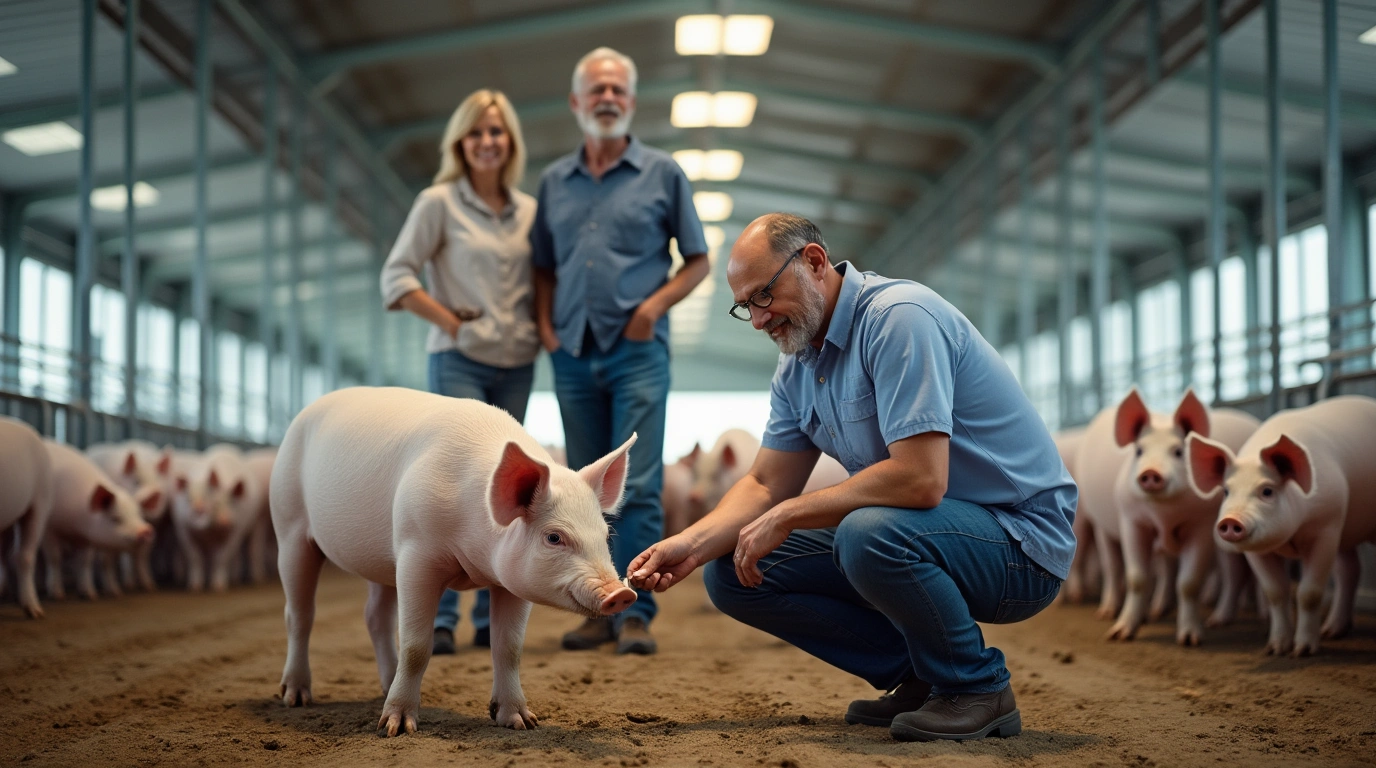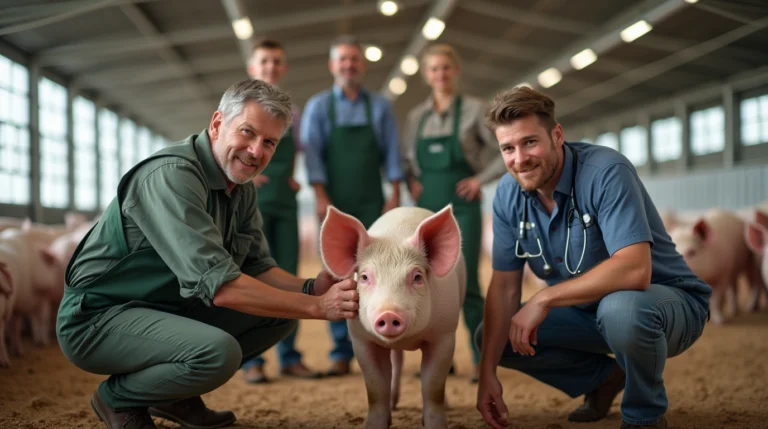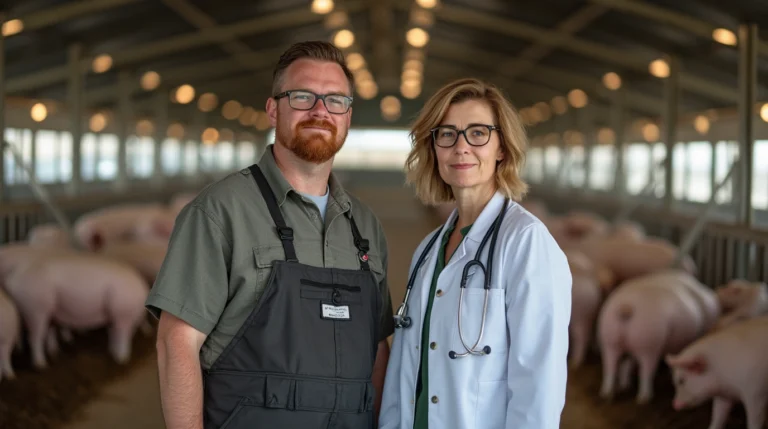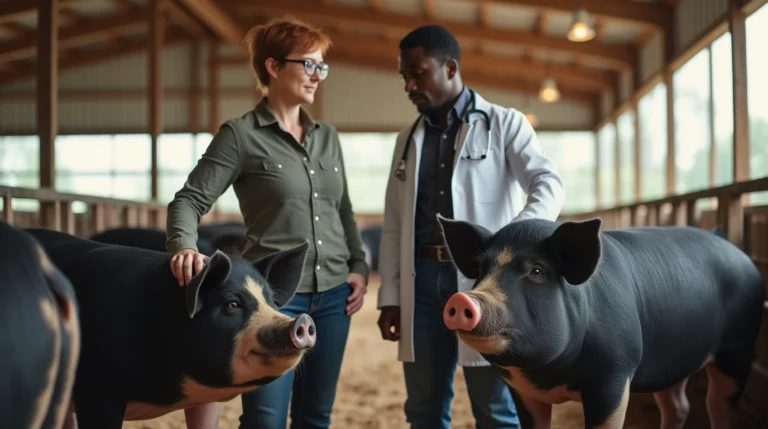Learn how to prevent swine dysentery in your pig herd with 6 proven strategies. Expert tips on biosecurity, nutrition, and early detection for healthy pigs.
Table of Contents

When it comes to raising healthy pigs, whether you’re managing a small hobby farm or caring for pet pigs, understanding and preventing swine dysentery should be at the top of your priority list. This devastating bacterial infection has the potential to wipe out entire herds, causing severe financial losses and heartbreak for pig owners worldwide.
Swine dysentery, caused by the spirochete bacterium Brachyspira hyodysenteriae, is one of the most serious digestive diseases affecting pigs today. This condition doesn’t discriminate—it can strike commercial operations, small family farms, and even those raising miniature pigs as beloved companions. The disease spreads rapidly through contaminated environments and can cause mortality rates of up to 90% in untreated herds.
The good news? With proper prevention strategies and early intervention, swine dysentery is entirely preventable. In this comprehensive guide, we’ll explore six powerful methods to protect your pigs from this dangerous disease, ensuring your herd remains healthy, productive, and thriving for years to come.
Understanding Swine Dysentery: The Silent Threat
What Is Swine Dysentery?
Swine dysentery is a mucohemorrhagic colitis—a severe inflammation of the large intestine that results in bloody diarrhea, dehydration, and potentially death. The disease primarily affects the cecum and colon, causing extensive damage to the intestinal lining and disrupting normal digestive processes.
The causative agent, Brachyspira hyodysenteriae, is a gram-negative, anaerobic spirochete that thrives in the oxygen-free environment of the pig’s large intestine. What makes this bacterium particularly dangerous is its ability to survive in the environment for extended periods, especially in moist conditions and organic matter.
Clinical Signs and Symptoms
Recognizing the early signs of swine dysentery can mean the difference between a manageable outbreak and a catastrophic loss. The disease typically progresses through several stages:
Acute Phase (Days 1-3):
- Watery diarrhea that quickly becomes mucoid
- Presence of blood and mucus in feces
- Dehydration and electrolyte imbalances
- Loss of appetite and lethargy
- Rapid weight loss
Chronic Phase (Days 4-14):
- Persistent bloody diarrhea
- Severe dehydration
- Sunken eyes and gaunt appearance
- Weakness and inability to stand
- Death in severe cases
Economic Impact and Statistics
The economic impact of swine dysentery extends far beyond immediate treatment costs. According to recent veterinary studies, outbreaks can result in:
- Mortality rates ranging from 5% to 90%
- Treatment costs averaging $15-25 per affected pig
- Reduced feed conversion efficiency by 15-20%
- Delayed market weights, extending finishing periods by 2-4 weeks
- Total economic losses of $50-100 per pig in severe outbreaks
![Infographic showing swine dysentery progression timeline with clinical signs and prevention checkpoints – Visual guide for pig owners to identify disease stages and implement prevention strategies]
1. Implement Comprehensive Biosecurity Measures
The Foundation of Disease Prevention
Biosecurity forms the cornerstone of any effective swine dysentery prevention program. This multi-layered approach focuses on preventing the introduction and spread of pathogenic organisms within your pig operation.
External Biosecurity Protocols:
Visitor Management:
- Establish a mandatory 48-hour downtime period for anyone who has been in contact with other pigs
- Provide disposable coveralls, boots, and gloves for all visitors
- Maintain a visitor log with contact information and recent pig exposure history
- Install hand washing and disinfection stations at all entry points
Vehicle and Equipment Sanitization:
- Create designated parking areas away from pig housing
- Disinfect all vehicles entering the property with approved virucidal agents
- Clean and disinfect all equipment before bringing it onto the premises
- Establish separate tools for different areas of the operation
Feed and Water Security:
- Source feed only from reputable suppliers with documented biosecurity programs
- Store feed in sealed containers protected from rodents and wild birds
- Test water sources regularly for bacterial contamination
- Install filtration systems if water quality is questionable
Internal Biosecurity Strategies
Facility Design and Maintenance:
- Implement all-in, all-out production systems where possible
- Design facilities with separate air spaces and drainage systems
- Install foot baths with fresh disinfectant between different pig areas
- Maintain proper ventilation to reduce humidity and pathogen survival
Personnel Protocols:
- Train all staff on proper biosecurity procedures
- Establish shower-in, shower-out protocols for high-risk operations
- Provide dedicated clothing and footwear for different production areas
- Implement strict protocols for movement between different age groups
Monitoring and Documentation
Effective biosecurity requires continuous monitoring and documentation:
- Weekly biosecurity audits using standardized checklists
- Temperature monitoring of disinfectant solutions
- Regular testing of disinfectant efficacy
- Documentation of all visitors, deliveries, and potential exposures
| Biosecurity Component | Implementation Frequency | Success Metrics |
| Visitor protocols | Every entry | 100% compliance rate |
| Vehicle disinfection | Every entry | Zero pathogen detection |
| Facility cleaning | Daily/Weekly | Visual cleanliness scores |
| Staff training | Monthly | Knowledge assessment scores |
| Water testing | Quarterly | Bacterial count limits |
2. Optimize Nutrition and Feed Management
The Gut Health Connection
Proper nutrition plays a crucial role in maintaining intestinal health and natural disease resistance. A well-balanced diet not only supports growth and production but also strengthens the pig’s immune system and promotes beneficial gut bacteria that compete with pathogenic organisms.
Essential Nutritional Components:
Protein Quality and Digestibility:
- Use highly digestible protein sources to reduce undigested protein in the large intestine
- Maintain crude protein levels appropriate for each production stage
- Consider amino acid supplementation to optimize protein utilization
- Avoid sudden dietary changes that can disrupt gut microbiota
Fiber Management:
- Include appropriate levels of soluble and insoluble fiber
- Use fermentable fiber sources to promote beneficial bacteria growth
- Avoid excessive fiber that may increase digesta transit time
- Consider prebiotics like fructooligosaccharides and mannanoligosaccharides
Feed Additives for Disease Prevention
Organic Acids: Organic acids have proven effective in reducing pathogenic bacteria while maintaining beneficial microorganisms:
- Formic acid: 0.5-1.0% in feed, effective against gram-negative bacteria
- Propionic acid: 0.3-0.6% in feed, excellent mold inhibitor with antibacterial properties
- Benzoic acid: 0.2-0.5% in feed, improves gut pH and reduces harmful bacteria
- Fumaric acid: 1.0-2.0% in feed, enhances digestibility and gut health
Probiotics and Prebiotics:
- Lactobacillus species: 10^6-10^8 CFU/g feed, colonize the gut and produce lactic acid
- Bacillus species: Heat-stable spore-forming probiotics that survive feed processing
- Yeast derivatives: Beta-glucans and mannanoligosaccharides support immune function
- Inulin and chicory root: Natural prebiotics that selectively feed beneficial bacteria
Feed Quality Control
Mycotoxin Management: Mycotoxins can compromise immune function and increase susceptibility to infectious diseases:
- Regular testing of grain ingredients for aflatoxin, fumonisin, and DON
- Use of mycotoxin binders when contamination levels exceed safe limits
- Proper grain storage with moisture control and pest management
- Regular cleaning and sanitization of feed mixing and delivery equipment
Feed Processing Standards:
- Maintain pelleting temperatures of 80-85°C for pathogen reduction
- Use appropriate particle size for optimal digestibility
- Implement HACCP principles in feed manufacturing
- Regular calibration of mixing equipment for consistent nutrient delivery
Water Quality Management
Clean, fresh water is essential for maintaining gut health and preventing disease transmission:
Water Testing Protocols:
- Monthly bacterial testing for total coliforms and E. coli
- Quarterly testing for heavy metals and chemical contaminants
- pH monitoring to ensure optimal range (6.5-8.5)
- Regular cleaning and disinfection of water systems
Treatment Options:
- Chlorination systems for bacterial control
- UV sterilization for pathogen reduction
- Acidification to optimal pH levels
- Filtration systems for removing particulates and contaminants
3. Establish Strategic Health Monitoring Programs
Early Detection Systems
Early detection of swine dysentery is critical for preventing widespread outbreaks and minimizing economic losses. A comprehensive monitoring program should include both routine surveillance and targeted diagnostic testing.
Daily Health Observations: Train caretakers to recognize subtle changes in pig behavior and appearance:
- Appetite monitoring: Track feed consumption patterns and identify pigs eating less
- Activity levels: Monitor for lethargy, reluctance to move, or isolation from group
- Fecal consistency: Daily observation of manure for changes in color, consistency, or odor
- Body condition: Weekly assessment of body weight and overall appearance
Systematic Record Keeping:
- Digital or paper-based health records for individual pigs or groups
- Daily mortality and morbidity logs with detailed descriptions
- Feed consumption records by pen or group
- Environmental data including temperature, humidity, and ventilation rates
Diagnostic Testing Strategies
Routine Surveillance:
- Monthly fecal sampling from different age groups and production areas
- PCR testing for Brachyspira hyodysenteriae in subclinical animals
- Serological testing to monitor exposure levels in the herd
- Post-mortem examinations of all mortality cases
Targeted Testing: When clinical signs suggest possible swine dysentery:
- Fresh fecal samples: Collect within 2 hours of defecation for optimal bacterial recovery
- Rectal swabs: Use sterile swabs for direct sampling from affected animals
- Necropsy samples: Collect cecal and colonic contents from recently deceased pigs
- Environmental samples: Test water sources, feed, and high-traffic areas
Laboratory Partnerships
Establishing relationships with veterinary diagnostic laboratories enhances your monitoring capabilities:
Selection Criteria:
- Accreditation by recognized veterinary organizations
- Experience with swine diagnostics and Brachyspira identification
- Rapid turnaround times for emergency cases
- Comprehensive testing panels including antimicrobial sensitivity
Sample Submission Protocols:
- Proper sample collection and preservation techniques
- Cold chain maintenance during transport
- Complete submission forms with clinical history
- Follow-up communication for result interpretation
Technology Integration
Modern technology can enhance monitoring efficiency and accuracy:
Electronic Monitoring Systems:
- RFID tags for individual animal identification and tracking
- Automated feed intake monitoring systems
- Environmental sensors for temperature, humidity, and air quality
- Mobile apps for data collection and real-time reporting
Data Analysis Tools:
- Statistical software for trend analysis and outbreak prediction
- Geographic information systems (GIS) for spatial analysis
- Predictive modeling for risk assessment
- Integration with veterinary practice management software
4. Develop Comprehensive Treatment Protocols
Antimicrobial Therapy Guidelines
When swine dysentery is confirmed or strongly suspected, immediate treatment is essential to prevent progression and spread. However, antimicrobial use must be judicious and based on current sensitivity patterns and regulatory guidelines.
First-Line Treatment Options:
Tiamulin:
- Dosage: 3.5-7.0 mg/kg body weight daily in feed
- Duration: 5-7 days for treatment, 14-21 days for prevention
- Mechanism: Inhibits bacterial protein synthesis
- Considerations: Excellent activity against Brachyspira hyodysenteriae
Lincomycin:
- Dosage: 2.2-4.4 mg/kg body weight daily in feed or water
- Duration: 7-14 days depending on severity
- Mechanism: Bacteriostatic effect on gram-positive bacteria
- Considerations: Good tissue penetration, effective against spirochetes
Tylosin:
- Dosage: 2.2-8.8 mg/kg body weight daily
- Duration: 5-10 days for acute cases
- Mechanism: Inhibits bacterial protein synthesis
- Considerations: Broad-spectrum macrolide with good oral absorption
Alternative Treatment Approaches
Organic Acid Therapy: High-dose organic acids can be effective for mild cases:
- Formic acid: 1.0-1.5% in drinking water for 5-7 days
- Propionic acid: 0.8-1.2% in feed during treatment period
- Combination products: Multi-acid formulations with synergistic effects
- Gradual withdrawal: Taper doses over 3-5 days to prevent rebound
Supportive Care Protocols:
- Electrolyte replacement: Oral or parenteral solutions for dehydration
- Nutritional support: High-quality, easily digestible feeds
- Environmental modification: Reduced stocking density and improved ventilation
- Stress reduction: Minimize handling and transportation during treatment
Treatment Monitoring and Evaluation
Clinical Response Assessment:
- Daily evaluation of fecal consistency and blood presence
- Appetite and water consumption monitoring
- Body weight changes and overall condition scoring
- Group behavior and activity level observations
Laboratory Follow-up:
- Post-treatment fecal testing at 7-14 days after therapy completion
- Confirmation of bacterial elimination through PCR or culture
- Antimicrobial resistance testing for treatment failures
- Serological monitoring for herd immunity development
Regulatory Compliance and Record Keeping
Withdrawal Periods: Strict adherence to withdrawal times ensures food safety:
- Tiamulin: 5-7 days depending on formulation and dosage
- Lincomycin: 6-12 days for different routes of administration
- Tylosin: 3-7 days based on regulatory requirements
- Documentation: Detailed treatment records for regulatory inspection
Veterinary Oversight:
- Valid veterinary-client-patient relationship (VCPR) required
- Prescription requirements for antimicrobial medications
- Regular consultation for treatment protocol updates
- Emergency treatment protocols for after-hours situations
5. Environmental Management and Sanitation
Facility Design for Disease Prevention
Proper facility design creates an environment that naturally discourages pathogen survival and transmission while promoting pig health and welfare.
Housing Configuration:
- All-in, all-out systems: Complete depopulation between groups allows thorough cleaning
- Separate air spaces: Independent ventilation systems prevent airborne transmission
- Proper drainage: Sloped floors with adequate drainage prevent standing water
- Easy-to-clean surfaces: Smooth, non-porous materials facilitate effective sanitation
Ventilation Management: Optimal air quality reduces pathogen load and stress on the immune system:
- Air exchange rates: 10-20 air changes per hour depending on season and stocking density
- Temperature control: Maintain thermoneutral zones for different age groups
- Humidity management: Keep relative humidity between 50-70% to minimize pathogen survival
- Air filtration: HEPA filters in high-risk facilities to remove particulates and pathogens
Cleaning and Disinfection Protocols
Multi-Step Sanitation Process:
Step 1: Physical Cleaning
- Remove all organic matter including manure, bedding, and feed residues
- Use high-pressure washing with hot water (60-70°C) when possible
- Pay special attention to corners, cracks, and hard-to-reach areas
- Allow surfaces to dry completely before proceeding to disinfection
Step 2: Disinfection Choose disinfectants based on pathogen spectrum and environmental conditions:
- Quaternary ammonium compounds: Effective against vegetative bacteria, gentle on surfaces
- Phenolic compounds: Broad spectrum activity, effective in organic matter
- Oxidizing agents: Rapid kill times, effective against spores and viruses
- Aldehyde-based products: Excellent penetration, effective at low temperatures
Step 3: Contact Time and Monitoring
- Follow manufacturer’s recommendations for contact time (typically 10-30 minutes)
- Monitor disinfectant concentration using test strips or digital meters
- Document cleaning and disinfection activities with date, time, and personnel
- Verify efficacy through environmental sampling and bacterial culture
Pest and Vector Control
Rodent Management: Rodents can serve as mechanical vectors for Brachyspira hyodysenteriae:
- Regular monitoring with tracking powder or bait stations
- Exclusion measures including door seals and wall repairs
- Habitat modification by removing feed sources and nesting materials
- Professional pest control services for severe infestations
Insect Control: Flies and other insects can transfer pathogens between pigs and facilities:
- Installation of screens on windows and ventilation openings
- Regular removal of organic matter that serves as breeding sites
- Use of approved insecticides in non-food areas
- Biological control methods including beneficial insects and parasites
Wild Bird Exclusion:
- Netting or screening to prevent bird access to feed and water
- Regular cleaning of areas where birds may roost
- Removal of standing water and food sources
- Sonic or visual deterrents in outdoor areas
Waste Management Systems
Manure Handling: Proper manure management prevents environmental contamination and pathogen recycling:
- Slurry systems: Regular pumping and proper lagoon management
- Solid manure: Composting to achieve pathogen-killing temperatures (55-65°C)
- Separation technologies: Reduce pathogen load in liquid fractions
- Land application: Follow nutrient management plans and setback requirements
Dead Animal Disposal:
- Rendering services for large operations
- On-farm composting for smaller facilities
- Incineration where permitted by local regulations
- Burial in approved locations with proper lime treatment
6. Emergency Response and Outbreak Management
Rapid Response Protocols
When swine dysentery is suspected or confirmed, immediate action can prevent widespread transmission and minimize losses. A well-defined emergency response plan should be activated within hours of initial detection.
Immediate Containment Measures:
Isolation Procedures:
- Immediate quarantine of affected pigs and their pen mates
- Restriction of animal movement between different areas
- Dedicated caretakers for affected groups to prevent cross-contamination
- Enhanced biosecurity measures including additional disinfection stations
Communication Protocols:
- Immediate notification of the attending veterinarian
- Contact with diagnostic laboratory for expedited testing
- Notification of regulatory authorities if required
- Communication with neighboring producers about potential risk
Enhanced Surveillance:
- Increased frequency of health observations (every 4-6 hours)
- Expanded sampling to include clinically normal animals
- Environmental sampling of water sources, feed, and high-traffic areas
- Temperature and mortality monitoring in all production areas
Treatment Implementation
Mass Medication Strategies: When multiple animals are affected, strategic mass medication may be necessary:
Water Medication:
- Calculate total daily water consumption for accurate dosing
- Use water-soluble formulations of approved antimicrobials
- Monitor water intake to ensure adequate medication consumption
- Provide alternative water sources if animals reduce consumption
Feed Medication:
- Medicated feed preparation using appropriate mixing procedures
- Careful calculation of inclusion rates based on feed consumption
- Quality control testing to ensure uniform distribution
- Storage and handling procedures to maintain medication stability
Individual Treatment: For severely affected animals requiring intensive care:
- Injectable antimicrobials for rapid systemic distribution
- Fluid therapy for dehydration and electrolyte imbalances
- Nutritional support through tube feeding if necessary
- Regular monitoring of vital signs and response to treatment
Recovery and Prevention
Facility Decontamination: After outbreak resolution, thorough facility cleaning and disinfection is essential:
- Empty periods: Minimum 7-14 days between groups in affected areas
- Deep cleaning: Complete removal of all organic matter and thorough washing
- Multiple disinfection cycles: Apply approved disinfectants with adequate contact time
- Environmental validation: Bacterial sampling to confirm pathogen elimination
Restocking Protocols:
- Introduce animals gradually with enhanced monitoring
- Source replacement animals from known disease-free herds
- Implement extended quarantine periods for new arrivals
- Continue enhanced surveillance for 30-60 days post-restocking
Long-term Monitoring:
- Monthly fecal sampling for 6 months post-outbreak
- Serological monitoring to track herd immunity levels
- Review and update biosecurity protocols based on outbreak investigation
- Staff retraining on updated prevention and detection procedures
Post-Outbreak Analysis
Investigation and Documentation:
- Thorough investigation of outbreak source and transmission patterns
- Documentation of timeline, clinical signs, and treatment responses
- Analysis of contributing factors including management, environment, and nutrition
- Development of corrective action plans to prevent recurrence
Economic Assessment:
- Calculate direct costs including treatment, mortality, and diagnostic testing
- Estimate indirect costs such as reduced performance and delayed marketing
- Analyze cost-effectiveness of different prevention and treatment strategies
- Use economic data to justify investments in improved prevention measures
Advanced Prevention Strategies
Vaccination Considerations
While no commercial vaccine is currently available for swine dysentery in most regions, research continues into vaccine development. Some experimental and autogenous vaccines have shown promise in specific situations.
Autogenous Vaccine Development:
- Created from isolates specific to individual operations
- Requires veterinary oversight and regulatory approval
- Limited efficacy data compared to commercial vaccines
- Primarily used in chronic problem herds with recurring outbreaks
Vaccination Protocol Development: When vaccines become available, consider these factors:
- Timing: Optimal age for initial vaccination and booster schedules
- Route of administration: Intramuscular, oral, or mucosal delivery systems
- Adjuvant selection: Enhanced immune response without adverse effects
- Monitoring: Serological testing to evaluate vaccine efficacy
Genetic Selection and Breeding
Disease Resistance Traits: Research has identified genetic factors that influence susceptibility to enteric diseases:
- Immunoglobulin levels: Higher baseline antibody production
- Gut barrier function: Stronger intestinal integrity and mucus production
- Inflammatory response: Balanced immune reaction to pathogenic challenges
- Growth performance: Maintained productivity under disease pressure
Breeding Program Integration:
- Selection indices that include health traits alongside production parameters
- Genomic testing for disease resistance markers
- Performance testing under controlled challenge conditions
- Collaboration with genetic suppliers to develop resistant lines
Precision Agriculture Applications
Sensor Technology: Advanced monitoring systems can detect early signs of disease before clinical symptoms appear:
- Activity monitors: Track movement patterns and feeding behavior
- Temperature sensors: Continuous body temperature monitoring
- Sound analysis: Vocal pattern changes indicating distress
- Automated weighing: Daily weight monitoring for growth rate changes
Data Analytics:
- Machine learning algorithms for pattern recognition
- Predictive modeling for outbreak risk assessment
- Real-time alerts for health parameter deviations
- Integration with management software for decision support
Economic Considerations and Cost-Benefit Analysis
Prevention Investment Analysis
Cost Categories:
Infrastructure Investments:
- Biosecurity facility improvements: $50-200 per pig space
- Ventilation system upgrades: $25-75 per pig space
- Water treatment systems: $10-30 per pig space
- Monitoring equipment: $15-50 per pig space
Operational Costs:
- Enhanced feed additives: $5-15 per pig annually
- Increased diagnostic testing: $2-8 per pig annually
- Additional labor for monitoring: $3-10 per pig annually
- Veterinary consultation: $1-5 per pig annually
Return on Investment: Prevention programs typically show positive returns within 1-2 years:
- Mortality reduction: 5-10% improvement saves $25-50 per pig
- Performance improvement: Better feed conversion worth $10-20 per pig
- Reduced treatment costs: Savings of $15-25 per pig per outbreak
- Market timing: Earlier market weights worth $5-15 per pig
Risk Assessment Matrix
| Risk Factor | Probability | Impact | Risk Score | Mitigation Cost |
| Poor biosecurity | High | High | 9 | $75-150/pig |
| Contaminated feed | Medium | High | 6 | $20-40/pig |
| Inadequate monitoring | Medium | Medium | 4 | $10-25/pig |
| Poor sanitation | High | Medium | 6 | $30-60/pig |
| Stress factors | Medium | Low | 2 | $5-15/pig |
Financial Planning Considerations
Insurance Options:
- Livestock mortality insurance covering infectious diseases
- Business interruption insurance for extended downtime
- Veterinary fee insurance for major health events
- Feed contamination insurance for nutritional problems
Emergency Fund Planning: Establish financial reserves for potential outbreaks:
- Treatment costs: $20-40 per pig in affected groups
- Extended feeding costs: $15-30 per pig for delayed marketing
- Facility cleaning and disinfection: $5-15 per pig space
- Replacement animal costs: Full purchase price plus transportation
Frequently Asked Questions
What are the first signs of swine dysentery I should watch for?
The earliest signs of swine dysentery include subtle changes in fecal consistency, with loose or watery manure appearing before the characteristic bloody diarrhea develops. Affected pigs may also show decreased appetite, reduced activity levels, and tend to isolate themselves from the group. The progression from normal feces to bloody, mucoid diarrhea typically occurs within 24-48 hours, making daily observation crucial for early detection.
How long can the swine dysentery bacteria survive in the environment?
Brachyspira hyodysenteriae can survive in moist, organic matter for several weeks to months, depending on environmental conditions. The bacteria survive longest in cool, humid conditions with temperatures between 15-25°C (59-77°F). In dried manure or clean, dry surfaces, survival is typically limited to days or weeks. This extended survival time emphasizes the importance of thorough cleaning and disinfection between animal groups.
Can swine dysentery be transmitted to humans or other animals?
Swine dysentery is primarily a disease of pigs and does not pose a direct health risk to humans. However, people can serve as mechanical carriers of the bacteria on clothing, boots, or equipment, facilitating transmission between pig groups or farms. Other animals, particularly rodents and birds, can also serve as mechanical vectors. Dogs have been reported to occasionally develop intestinal infections with Brachyspira species, though this is rare.
What’s the difference between swine dysentery and other causes of bloody diarrhea in pigs?
Swine dysentery is characterized by mucohemorrhagic colitis with distinctive clinical signs including profuse bloody diarrhea with mucus, rapid progression, and high mortality rates if untreated. Other conditions like salmonellosis, proliferative enteropathy, or whipworm infections may cause similar symptoms but typically have different patterns of progression, age group susceptibility, and response to treatment. Definitive diagnosis requires laboratory testing to identify the specific causative organism.
How effective are organic acids compared to antibiotics for treating swine dysentery?
Organic acids can be effective for mild cases or as preventive measures but are generally less effective than specific antimicrobials for treating acute swine dysentery outbreaks. Acids work by lowering gut pH and creating an unfavorable environment for pathogenic bacteria, but they may not achieve the rapid bacterial elimination needed in severe cases. Many producers use organic acids as part of a comprehensive prevention program alongside other management practices, reserving antimicrobials for confirmed cases requiring immediate intervention.
Should I quarantine new pigs before introducing them to my herd?
Yes, quarantine is essential for preventing the introduction of swine dysentery and other diseases. New arrivals should be isolated for a minimum of 30 days, with some experts recommending 45-60 days for high-risk situations. During quarantine, conduct health monitoring, diagnostic testing, and gradual acclimatization to your feeding and management systems. This period allows detection of incubating diseases and adaptation to your specific environment before mixing with the resident herd.
Take Action to Protect Your Herd Today
Implementing these six powerful prevention strategies requires commitment and investment, but the protection they provide for your pigs is invaluable. Start with a comprehensive assessment of your current practices, identify areas for improvement, and develop a systematic implementation plan.
Remember that prevention is always more cost-effective than treatment. By investing in biosecurity, nutrition, monitoring, and proper management, you’re not just preventing swine dysentery—you’re creating an environment where your pigs can thrive and reach their full potential.
For more expert pet care tips and product recommendations, visit BlithePet.com — your trusted source for pet wellness.
Conclusion
Swine dysentery remains one of the most serious threats to pig health worldwide, but it’s entirely preventable with the right approach. The six strategies outlined in this guide—comprehensive biosecurity, optimized nutrition, strategic health monitoring, effective treatment protocols, environmental management, and emergency preparedness—form a robust defense system against this devastating disease.
Success in preventing swine dysentery requires a holistic approach that addresses all aspects of pig management. From the moment animals arrive on your farm to their eventual departure, every decision you make can either increase or decrease their risk of disease exposure. By implementing these evidence-based strategies and maintaining vigilant monitoring, you can protect your herd while ensuring optimal health and productivity.
The investment in prevention pays dividends not only in avoided losses but also in improved overall herd health, better performance, and peace of mind. Your pigs depend on you for their health and welfare—make the commitment to implement these protective measures today.
Have a similar experience with your pet? Share it in the comments below!






Leave a Reply